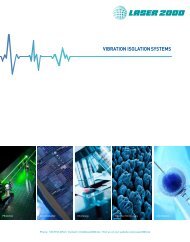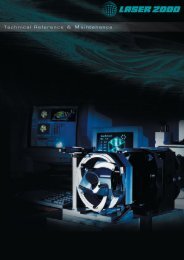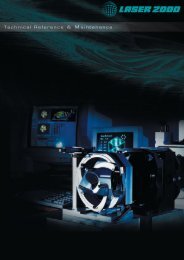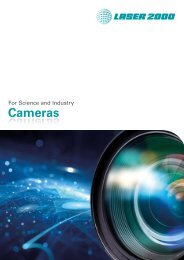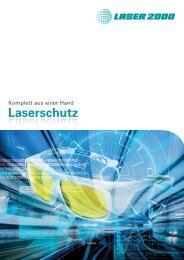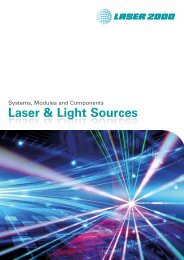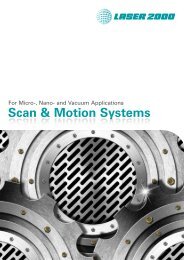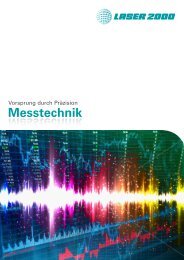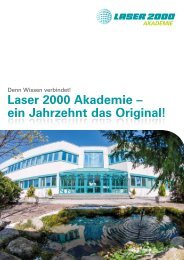Semrock Master Catalog 2018
Semrock Master Catalog 2018
Semrock Master Catalog 2018
You also want an ePaper? Increase the reach of your titles
YUMPU automatically turns print PDFs into web optimized ePapers that Google loves.
Fluorophores<br />
Single-band<br />
Sets<br />
Multiband<br />
Sets<br />
Cubes Laser<br />
Sets<br />
BrightLine ® Dichroic Super-resolution / TIRF Laser<br />
Dichroic Beamsplitters<br />
TECHNICAL NOTE<br />
incident<br />
wavefront<br />
reflected<br />
wavefront<br />
Choosing Dichroic Beamsplitters with Flatness/<br />
RWE Appropriate to the Microscopy Method<br />
Wavefront distortion can degrade image quality by reducing contrast or<br />
compromising resolution. In several microscopy applications, reducing<br />
wavefront distortion is critical to achieving the microscopy method. Specifying<br />
and selecting optical filters that minimize wavefront aberration is important to<br />
maximize or enable optical system performance. This article elucidates how to<br />
select optical filters for high performance microscopy, and provides guidance on<br />
choosing <strong>Semrock</strong> catalog filters for wavefront distortion performance required<br />
for applications.<br />
reflected flatness<br />
wavefront<br />
Both standard and advanced microscopy methods require error certain minimum<br />
standards of flatness on dichroic beamsplitters. For example, super-resolution<br />
and TIRF microscopy cannot be achieved if the flatness of the critical dichroic<br />
beamsplitters is worse than required. This Tech Note introduces the topic of how to<br />
choose <strong>Semrock</strong> dichroic beamsplitters appropriate to the microscopy method.<br />
incident<br />
wavefront<br />
reflected<br />
wavefront<br />
flatness<br />
reflected<br />
wavefront<br />
error<br />
Figure [1]: For light incident at an angle upon a dichroic<br />
beamsplitter, deviations from flatness cause distortions in<br />
the reflected wavefront.<br />
Optical filters are generally composed of multi-layered, thin-film coatings on plane, parallel glass substrates. There is variability in substrate<br />
flatness, and, additionally, the substrate may slightly bend after coating. For transmitted light, such bending has little effect on transmitted<br />
wavefront Total error TWE (TWE) other than a = slight displacement Tiltof the beam axis. However, + for reflected Spherical light, especially light + incident at Irregularity<br />
nonperpendicular<br />
angles, deviations from flatness TWE (see Contribution<br />
Figure 1) have two effects on reflected TWE wavefront Contribution error (RWE): (1) the focal TWE plane Contribution<br />
may<br />
shift position, or (2) the beam may acquire optical aberrations (e.g., astigmatism).<br />
2 μm<br />
Figure [2]: Image sequence demonstrating the effect of substrate bending on image<br />
quality. A lower radius of curvature means greater substrate bending. As the radius<br />
of curvature decreases (and bending increases), image quality degrades. [Images of<br />
F-actin in bovine pulmonary artery endothelial cells (FluoCells® Prepared Slide #1,<br />
ThermoFisher Scientific, Waltham, MA, USA) as imaged on a BX41 microscope (Olympus<br />
Corporation of the Americas, Center Valley, PA, USA) with a 40×, 0.75NA objective and<br />
Retiga camera (QImaging, Surrey, BC, Canada)]<br />
NLO<br />
Filters<br />
Individual<br />
Filters<br />
Dichroic<br />
Beamsplitters<br />
incident<br />
transmitted<br />
incident transmitted<br />
wavefront<br />
wavefront<br />
wavefront wavefront<br />
Radius of Curvature (m) ~6 ~1275<br />
Microscopy Technique<br />
incident<br />
wavefront<br />
Flatness Need in a Reflected<br />
Excitation Beam<br />
transmitted<br />
wavefront<br />
Widefield Fluorescence Microscopy Non-critical Critical<br />
Total Internal Reflection Fluorescence (TIRF) Microscopy Critical Critical<br />
incident<br />
wavefront<br />
A focal plane shift can be corrected by lens or camera adjustment in some microscopy methods, but in others this shift cannot be<br />
adjusted for and can therefore impede proper function. Also of significant concern, optical aberrations can degrade image quality, as<br />
illustrated in Figure [2], and can compromise the microscopy method. In determining suitable flatness need for a given application, the<br />
most important parameter is often the diameter of the beam striking the dichroic beamsplitter surface. Table 2 shows the <strong>Semrock</strong><br />
product best suited to the application, for maximum diameter values. For more specific information, and for other beam diameter<br />
value and microscopy examples, the <strong>Semrock</strong> White Paper on this topic [1] provides additional information on RWE, TWE, and<br />
microscopy methods, as well as guidance from a system designer’s perspective.<br />
Because of potential degradation of imaging quality, it is important to determine when the flatness of dichroic beamsplitter is<br />
critical to a microscopy method. Table 1 lists examples of popular microscopy techniques in which it is critical to have dichroics of<br />
high flatness. As noted in this table, high flatness requirements can apply to both the illumination (excitation) and the detection<br />
(emission) light paths.<br />
Flatness Need in a Reflected<br />
Emission Beam<br />
transmitted<br />
wavefront<br />
Stochastic Switching (PALM, STORM, etc.) Critical Critical<br />
Tunable<br />
Filters<br />
Stimulated Emission Depletion (STED) – Pulsed Microscopy Critical Non-critical<br />
Confocal Single-point Scanning Microscopy Critical Non-critical<br />
Combining multiple laser beams Critical Not applicable<br />
More<br />
68<br />
Table 1: A list of popular standard and advanced microscopy methods, categorized as to criticality of dependence on reflected wavefront flatness.<br />
(continued)



